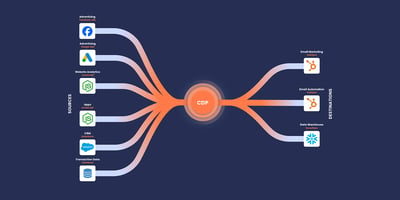Lead qualification is the systematic process of classifying prospects based on their readiness and willingness to buy a product or service from your company.
It is also about gathering the right insights on your ideal buyer so you can make a sound judgement on them.
Whether you are a marketer or a salesperson, it’s important to focus on the right leads that come through the funnel and at the right time.
Using the solid criteria for sales and marketing leads is integral to an effective sales enablement strategy. How else would you know who to market/talk to if you don’t know who your ideal buyer is?
Marketers: How do you qualify a prospect?
Setting up buyer personas is crucial in distinguishing who your ideal buyer is. What do they need? Why they need it? And of course, how you will go about in helping them solve these needs?
If your company has the right personas in place, you can easily reference them when qualifying your prospects.
The basis on which you qualify your prospects can be broken down into the following aspects:
1. Customer profiling
The first question that you need to ask is: Does this lead fit my qualifying personas? If you don’t know who your target persona is, then you have some work to do in terms of mapping out a persona document.
2. Their needs
Most individuals generally buy to reduce 'pain', so if there isn't any pain, or you can't identify it, there probably isn't a chance of a sale. It's a junk lead.
In addition, your business solutions should align on how to best give your potential customers what they are looking to solve for.
A prospect might have downloaded an eBook from your website, but they might not be a legitimate buyer. Sales and marketing teams need to qualify each lead before converting them into an opportunity.
3. The decision-making process
Who is the key buyer, and how many people are involved in this process? It's also a good idea to determine the length it takes them to purchase. From these two factors you are then able to determine if the lead is a good fit for your business.
4. Your competition
How many competitors does your business have, and how do your offerings differ from theirs? Are you unique? Tracking your competitors' business practices and determining what works best for them will show you where you might have an advantage over them on a particular prospect.
5. Is their business within your defined target location?
Your business strategy should define your place of operation, and will also speak to your key target geographic areas.
Most B2B companies will be operating in large cities, but increasingly, using more granular geographical information, salespeople can hone in on their key area codes, suburbs, and even streets.
This information can also help you to filter prospects based in outlying areas, which makes the sales job that little bit easier.
Salespeople: How do you qualify a prospect?
The above-mentioned are all factors to take into consideration when qualifying a lead using an inbound marketing approach. Now let’s talk a bit about a few factors that help hone in on the lead qualification process if you are a salesperson.
Sales teams have spent a long time figuring out what frameworks they use for their lead qualification process. Different industries favour different methods. But a long-standing method is BANT.
Using the BANT framework, you can determine a potential lead's readiness to open up about their needs, frustrations and certain pain points that might come up.
Using the BANT framework also distinguishes whether or not your lead is a good fit for your business:
- Budget; do these leads have the ability to spend?
- Authority; this brings us back to the previously mentioned decision making process. Who is responsible for allocating spend? According to research from CEB, it now takes an average of 5.4 people to make a buying decision, so the “ultimate” buying authority could be more than one person.
- Need; does the prospect have an urgent problem that needs to be addressed, and how will you go by addressing these needs?
- Timing; life is all about timing. Customers look to your business to fill a void they have, and you can easily fill this void if all the above factors are met, and put in practice at the precise moment.
Final Thoughts
Whether you use BANT or the inbound marketing qualification methodologies above you age going to be on the right track.
Just remember that not every lead is worth a follow up or being passed onto the sales team. Use the qualification methodologies to only work on the lead likely to turn into opportunities.
Pro Tip: You need a CRM to mark leads a qualified of not. Just remember that not all CRM systems need to come with a hefty price tag. HubSpot offers a free, yet robust, CRM system that can help you track your deals and manage your pipeline while maintaining all your contact information in one easy-to-access place.





